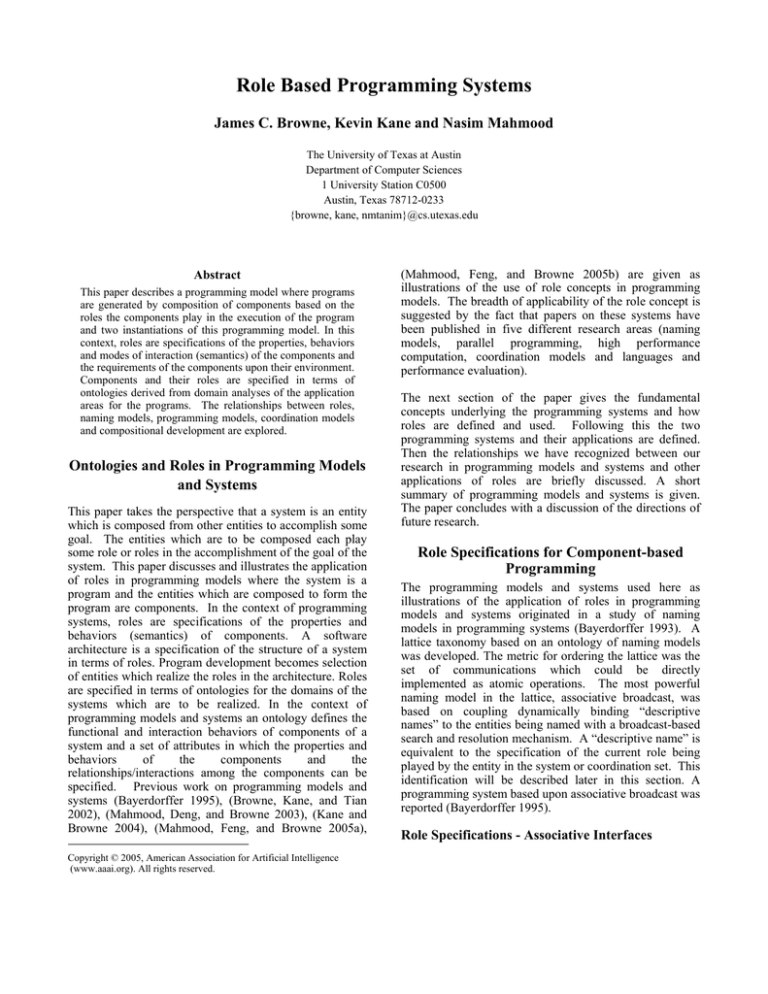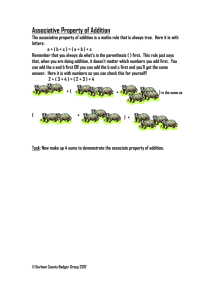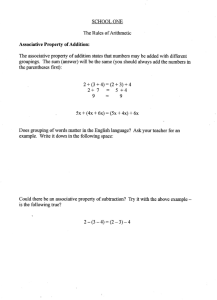
Role Based Programming Systems
James C. Browne, Kevin Kane and Nasim Mahmood
The University of Texas at Austin
Department of Computer Sciences
1 University Station C0500
Austin, Texas 78712-0233
{browne, kane, nmtanim}@cs.utexas.edu
Abstract
This paper describes a programming model where programs
are generated by composition of components based on the
roles the components play in the execution of the program
and two instantiations of this programming model. In this
context, roles are specifications of the properties, behaviors
and modes of interaction (semantics) of the components and
the requirements of the components upon their environment.
Components and their roles are specified in terms of
ontologies derived from domain analyses of the application
areas for the programs. The relationships between roles,
naming models, programming models, coordination models
and compositional development are explored.
Ontologies and Roles in Programming Models
and Systems
This paper takes the perspective that a system is an entity
which is composed from other entities to accomplish some
goal. The entities which are to be composed each play
some role or roles in the accomplishment of the goal of the
system. This paper discusses and illustrates the application
of roles in programming models where the system is a
program and the entities which are composed to form the
program are components. In the context of programming
systems, roles are specifications of the properties and
behaviors (semantics) of components. A software
architecture is a specification of the structure of a system
in terms of roles. Program development becomes selection
of entities which realize the roles in the architecture. Roles
are specified in terms of ontologies for the domains of the
systems which are to be realized. In the context of
programming models and systems an ontology defines the
functional and interaction behaviors of components of a
system and a set of attributes in which the properties and
behaviors
of
the
components
and
the
relationships/interactions among the components can be
specified. Previous work on programming models and
systems (Bayerdorffer 1995), (Browne, Kane, and Tian
2002), (Mahmood, Deng, and Browne 2003), (Kane and
Browne 2004), (Mahmood, Feng, and Browne 2005a),
Copyright © 2005, American Association for Artificial Intelligence
(www.aaai.org). All rights reserved.
(Mahmood, Feng, and Browne 2005b) are given as
illustrations of the use of role concepts in programming
models. The breadth of applicability of the role concept is
suggested by the fact that papers on these systems have
been published in five different research areas (naming
models, parallel programming, high performance
computation, coordination models and languages and
performance evaluation).
The next section of the paper gives the fundamental
concepts underlying the programming systems and how
roles are defined and used. Following this the two
programming systems and their applications are defined.
Then the relationships we have recognized between our
research in programming models and systems and other
applications of roles are briefly discussed. A short
summary of programming models and systems is given.
The paper concludes with a discussion of the directions of
future research.
Role Specifications for Component-based
Programming
The programming models and systems used here as
illustrations of the application of roles in programming
models and systems originated in a study of naming
models in programming systems (Bayerdorffer 1993). A
lattice taxonomy based on an ontology of naming models
was developed. The metric for ordering the lattice was the
set of communications which could be directly
implemented as atomic operations. The most powerful
naming model in the lattice, associative broadcast, was
based on coupling dynamically binding “descriptive
names” to the entities being named with a broadcast-based
search and resolution mechanism. A “descriptive name” is
equivalent to the specification of the current role being
played by the entity in the system or coordination set. This
identification will be described later in this section. A
programming system based upon associative broadcast was
reported (Bayerdorffer 1995).
Role Specifications - Associative Interfaces
A role specifies the services and behaviors of a component
and the dependencies of a component on other
components. The behaviors and dependencies together
determine the role or roles that component can play in a
composition or coordination system. The first requirement
is a language in which to specify the roles of components.
We specify roles in terms of an interface definition
language which is used to encapsulate an executable
segment of code. These role specifications are called
associative interfaces because they enable association, or
composition, of components on the basis of their roles.
Component: A component is an entity which fulfills one
or more requirements, and plays a possibly dynamic set of
roles, for the execution of a system of which it is a part.
A role specification, which we implement as an associative
interface),consists of an accepts specification and a
requires specification.
Accepts Specification: An accepts interface specifies the
set of interactions in which a component is willing to
participate. The accepts interface for a component is a
three-tuple (profile, coordination/interaction, protocol).
• A profile incorporates the information necessary to
characterize the properties and behaviors of a
component and to enable the compositional mechanism
to select components meeting the requirements for
efficient implementation of a given instance of an
application family for a given execution environment.
A profile may dynamically change during execution to
reflect changes of state of a component. A profile is a
set of attribute/value pairs.
• The coordination/interaction of components is managed
by a state machine implemented in the profile each
component. Each state of the state machine incorporates
is a guarded command with a condition for the
execution of the function and a function signature
including the data types, functionality and parameters of
the unit of work to be executed and a specification for
the component state in which execution of this function
is enabled. The state machine is defined in the form of
expressions in a linear propositional temporal logic over
the attributes and state variables of the component. A
function signature and its enabling condition are called
a transaction. A transaction can be enabled or disabled
based on its current state and its current state can be
used in runtime binding of the components. The state
machine can be used to represent complex interactions
such as precedence of transactions, "and" relationships
among transactions and "or" relationships among
enabling states and transactions.
• A protocol defines a sequence of simple interactions
necessary to complete the interaction specified by the
profile. The most basic protocol is data-flow, which is
defined as executing the functionality of a component
and transmitting the output to a set of successors
defined by the requires interface at that component
without returning to the invoking component.
Requires Specification: A requires interface specifies the
set of interactions which a component must initiate if it is
to complete the interactions it has agreed to accept. The
requires interface is a set of three-tuples (selector,
transaction, protocol). A component can have multiple
tuples in its requires interface to implement its required
functionality.
• A selector is a conditional expression over the attributes
of the components in the domain.
• Transaction specifications are similar to those for
accepts specifications except that the state machine is a
single state.
• Protocol specifications are as given for accepts
specifications.
Start Component: A start component is a component that
has at least one requires interface and no accepts interface.
Every program requires a start component. There can be
only one start component in a program which provides a
starting point for the program.
Stop Component: A stop component is a component that
has at least one accepts interface and no requires interface.
A stop component is also a requirement for termination of
a program. There can be more than one stop component of
a program denoting multiple ending points for the
program. A non-terminating program may reach a stop
node only in the case of an error or fault.
Composition and Coordination
The conditional expression of a selector is a template
which has slots for attribute names and values. The names
and values are specified in the profiles of other
components of the domain. Each attribute name in the
selector expression of a component behaves as a variable.
The attribute variables in a selector are instantiated with
the values defined in the profile of another component.
The profile and the selector are said to match when the
instantiated conditional expression evaluates to true.
Composition is usually defined in terms of binding
invocations of a method or procedure by one component to
a method or procedure in an implementing component.
Composition may, although the mechanisms differ, occur
at compile time, at link/load time, and at run time such as
through RPC. Composition at compile time and/or link
time is accomplished through associative search of
libraries as defined in the first paragraph of this section.
Communication/interaction and thus coordination among
components at runtime is by (conceptually) broadcasting
messages where the address of the message is a selector
clause from the requires interface. This communication
model is called associative broadcast. The selector in each
broadcast message is locally matched with the profile of
each object in the broadcast domain. Messages are
received only by those components whose profiles cause
the selector of the message to evaluate to true. Matching
of a selector to a component profile is atomic with respect
to a profile's modification. It is therefore possible for a
sender's target set to change during transmission if a
profile is changed, but the matching criteria will not
change for a component once matching begins. Matching
is done locally and asynchronously upon "arrival" of the
message. In practice, associative naming and binding are
used as a compilation process to select an initial set of
bindings among components prior to runtime.
b. Component Development – Specify and either design
and implement or discover in existing libraries, the
family of components identified in the domain analysis
in an appropriate sequential procedural language.
c. Encapsulation – Encapsulate the components with
associative role specifications. The interfaces must
differentiate the components by identifying their
properties in terms of the attributes defined in the
domain analysis.
Both compile time and runtime composition are based on
the specification of roles in the form of associative
interfaces and upon matching of the requirements of one
component with a role played by some other component.
Therefore the associative model of interaction unifies
coordination and composition.
b.
Programming Model
Program Instance Development
The steps in specifying a given instance of an application
are:
a.
c.
d.
The programming model has two phases: development of
families of components and specification of the instances
of the family of programs which can be instantiated from
the sets of components.
Component Development
A role may be realized by a several different components.
The choice of which component to use to fulfill the role
may depend on the implementation of the component.
Therefore, role specifications are extended to include nonfunctional properties such as performance or possible
parallel execution. The set of components which enables
construction of a family of application programs may
include components which utilize different algorithms for
different problem instances or different implementation
strategies for different execution environments.
A
program for a given problem instance or given execution
environment is composed from appropriate components by
selecting desired properties for the components and the
properties of the execution environment in the Start
component.
The steps for developing components are:
a. Ontology Development – Execute the necessary
domain analyses. It is usually the case that applications
require components from multiple domains.
e.
f.
Analyze the problem instance and the target execution
environment. Identify the attributes and attribute
values which characterize the components desired for
this problem instance and execution environment.
Construct an architecture for the instance of the
program in terms of roles extended with nonfunctional properties.
Identify the components from which the application
instance will be composed. If the needed components
are
not
available
then
some
additional
implementations of components may be necessary
together with an extension of the domain analysis.
For parallel programs or programs to be executed in
unreliable execution environments, specify the number
of replications desired for parallelism and for faulttolerance. Incorporate these specifications into the
component interfaces or as parameters in the Start
component if parameterized parallelism has been
incorporated into the component interfaces.
Define a Start component which initializes the
replication parameters, sets attribute values needed to
ensure that the components implementing the
appropriate implementations of roles are selected and
matched.
Define at least one Stop component.
Instantiations of Role-Based Programming
This section sketches two instantiations of programming
systems utilizing role-based composition and coordination:
P-COM2 (Mahmood, Deng, and Browne 2003) and
CoorSet (Kane and Browne 2004).
P-COM2
The principal elements of P-COM2 are the interface
definition language in which roles are defined as
associative specification, a compiler which automatically
selects components whose roles compose to implement a
given system as previously described and a runtime system
which enables composition to continue at runtime by
substituting
components
which
implementations of a given role.
have
different
The principal concerns and goals for the P-COM2 project
have been:
• to enable automation or at least partial automation of
composition of programs from components,
• to integrate compile time and runtime composition of
components,
• to generate parallel and distributed programs adapted
to the problem instance and execution environment
and
• to
enable
performance-oriented,
evolutionary
development of parallel and distributed programs.
The first and third goals are discussed in (Mahmood,
Deng, and Browne 2003). The second goal is addressed in
(Mahmood, Feng, and Browne 2005a) and the fourth goal
is addressed in (Mahmood, Feng, and Browne 2005b).
The source program for the P-COM2 compilation process
is a start component with a sequential computation which
implements initialization for the program and a requires
interface which specifies the components implementing the
first steps of the computation and one or more libraries to
search for components which play the roles defined in the
domain analysis. The set of components which is
composed to form a program is primarily dependent on the
requires interface of the start component.
The target language for the compilation process is a
generalized data flow graph as defined in (Newton and
Browne 1992). A node in this data flow graph consists of
an initialization, a firing rule, a sequential computation and
a routing rule for distribution of the outputs of the
computation. There are two special node types, a start
node and a stop node. Acceptable data flow graphs must
begin with a start node and terminate on a stop node. The
nodes of the data flow graph are the components, the arcs
result from matching of accepts and requires interfaces and
the firing rules are derived from the state machines
associated with the accepts specification.
Components can be replaced at runtime by a runtime
modification of a requires interface. The runtime system,
when it encounters the need to link a new component,
utilizes the dynamic linkers available in most operating
systems. Details can be found in (Mahmood, Feng, and
Browne 2005a).
Roles also enable composition of programs where some
components are abstract models such as performance
models
and
other
components
are
concrete
implementations of full functionality. The specification
for the roles played by a component is extended to include
“abstract” or “concrete” and the compiler and runtime
system extended accordingly. Details can be found in
(Mahmood, Feng, and Browne 2005b).
Coordination Models and CoorSet
The goal of this application of roles is to enable
development of distributed applications where control is
fully distributed. It is assumed the components from an
application or family of applications is to be developed are
located at different sites in a distributed system and are
active.
Therefore, coordination and composition of
application becomes search to identify the needed
components and then coordination among the components.
The goal was accomplished in two steps. (Browne, Kane,
and Tian 2002) reports a coordination model based on
associative interface based specification of roles. A
subsequent paper (Kane and Browne 2004) extends the
coordination model to enable convenient programming of
distributed applications and presents a language for
specification of interfaces and initial system
configurations.
The CoorSet programming system has four elements: an
interface definition language in which to specify roles, a
runtime system implementing associative broadcast, a
compiler for generation of initial conditions and a support
system for creating distributed configurations of
components.
The coordination model will be referred to as
Associatively Specified Interactions (ASI). ASI is a model
of coordination amongst a group of components. A
component is an implementation of a role required for the
execution of the system. The ASI implementation of a
component is one or more functions encapsulated by an
interface which specifies the role of the component and its
implementation. In contrast to P-COM2 where components
are explicitly linked, all interactions are through
associatively broadcast messages. In the ASI protocols, a
target set specification (the selector) travels with each
message that is broadcast onto the network. The target set
is determined for each message by the recipients whose
local state satisfies the target specification just as described
for the compilation in P-COM2 but the bindings are
transient. The sender does not know the membership of
this set, and does not necessarily ever discover it.
Broadcast communication is unique in that it directly
implements exhaustive search. It also can be shown to
enable attainment of consensus in a distributed system
under asynchronous execution. Protocols implementing
acknowledgements can be implemented if needed for a
given coordination problem.
The ASI coordination model has been extended to include
the same data flow semantics as is used in the target
language of P-COM2. The model thus incorporates two
additional features: complex conditions for enabling
execution of a component and replication for both
representation of SPMD parallelism and fault-tolerance.
These features are described (somewhat redundantly) here
since they now appear in a data flow graph representation
in the CoorSet interface definition language.
The conditions for executing and action of a component
commonly include receipt of multiple messages. To
maintain separation of concerns it is necessary to
incorporate this requirement into the coordination model.
We introduce the concept of a “firing rule” directly into
the coordination model. A firing rule is a specification of
the set of messages which must be received to initiate any
action of a component. Additionally, since components
may and often will have persistent state, there may be
precedence relations among possible enabling message
sequences. These extensions are accomplished by adding
types to messages and incorporating a conditional
expression over message types and local state into the
associative interface.
The definition of firing rules used in the extended
coordination model is taken from a data flow programming
model (Newton and Browne 1992), where rather than
waiting on a single input, a node in a data flow graph waits
on multiple inputs, possibly in a particular order, before
becoming enabled for execution. Firing rules are specified
with a Java-like logical syntax. Specifying reception of
either of two message types R, S is done with a rule “R ||
S”. Reception of both of two message types is specified
with a rule “R && S”. Reception of R followed by S is
specified with a rule “R < S”. These rules can be
compounded and grouped with parentheses, such as “(R <
S) || (R < T)”. The ‘<’ operator has the lowest precedence,
followed by `||’, and `&&’ has the highest precedence.
Replication is another feature that must be included in
associative interaction specifications to enable facile
specification of parallelism and fault-tolerance. SPMD
parallelism can be readily implemented by replication of
components.
Replication of functionality for faulttolerance can be made transparent and synchronizationfree after initialization. If an initiating component starts
several replicas of a given component to insure success in
an unreliable environment and each of the replicated
components responses by associative broadcast then the
initiating component can safely proceed after the first
successful result and set its profile to ignore the other
completions. A component can be replicated by adding an
index attribute to its profile and instantiating replicas in
conformance to the index range. Once specified, a
component can be started an arbitrary number of times.
The runtime system provides unique identifiers in a
predictable way so replicas can alter their behavior, or they
can all execute in the same way depending on the needs of
the application.
CoorSet has been applied to implementation of distributed
computations including a distributed computation of
Google’s page rank (Sankaralingam, Sethumadhavan, and
Browne 2003).
Relationship of Role-Based Programming to
other Uses of Roles
The most directly related research we have found is
(Guarino 1998). Guarino constructs ontologically based
relationships among components which can be composed
to implement software systems. The possibility of
ontologically based composition is discussed in the context
of both “development” time and runtime. This work is
entirely conceptual and reports no implementation or
application.
Coordination Models
The most direct relationship is with tuple-space based
coordination models (Gelertner 1985). The profile contains
the match variables of a tuple. Selectors play the role of
tuple templates. Each process or component which is
activated by a selector/tuple match may send messages as a
result of the action it executes which may bind it to other
components. Thus associative broadcast interactions can
viewed as being based on implementation of a distributed
tuple space with active linked tuples. Also the tuple space
communication model also lies at the top of the lattice
taxonomy of communication models. Finally, note that
Linda was initially introduced as a parallel programming
system.
Other Role-Based Programming Systems
There are at least three active research communities in
programming systems implicitly using role-based
specifications for components:
Web services, Grid
systems, and high performance computing (Armstrong and
Gannon 1999), (Bernholdt et. al. 2002), (Kane and Browne
2004).
The CoorSet programming model is equivalent to a
production rule system (Wu, Miranker, and Browne 1996)
where the entities in the working store are distributed and
the search for entities which match rule is implemented
through associative broadcast.
Machine Learning
The characterization of entities used in machine learning
and questioning answering systems (Clark and Porter
1997) have a startlingly similar format and content to the
associatively specified roles used in P-COM2 and CoorSet.
The process of forming question answering trees where
each “fact” plays its role in answering the question is a
search similar to the search made for a component
satisfying a role in a computation.
Software Architecture and Composition
Languages
Software architectures (Perry 1989) implicitly use roles to
identify the structure of the systems defined by an
architecture. In some cases, attributes are used to define
roles. For example, ArchJava (Aldrich, Chambers, and
Notkin 2002) annotates ports with provides and requires
methods which helps the programmer to better understand
the dependency relations among components by exposing
it to the programmer. Darwin (Magee, Dulay, and Kramer
1993) is a composition and configuration language for
parallel and distributed programs. Darwin uses a
configuration script to compose programs from
components.
Networking
Intentional names (Schwartz 1999) which are used in
networks to support routing and search specify roles by
using static forms of associatively specified names.
Conclusions and Future Research
Role specifications can be viewed as specifications for the
semantics of a component. Use of role specifications is the
critical enabler for migration of programming to
component composition.
Without effective machine
usable specification of semantics at the component level
(which are provided by roles) programming by component
composition cannot be attained.
We are extending the use of role specifications to include
subsumption and containment relations on role
specifications to enable more powerful selection of
components for composition and coordination. We are
also embedding role-based interactions in the SETI@home
model of computation to extend it to a more general class
of computations.
In Proceedings of the 8th IEEE International Symposium
on High Performance Distributed Computation, 115-124.
New York: Institute of Electrical and Electronics
Engineers.
Bayerdorffer, B. 1993. Associative Broadcast and the
Communication Semantics of Naming in Concurrent
Systems, Ph.D. diss., Dept. of Computer Sciences,
University of Texas at Austin.
Bayerdorffer, B. 1995. Distributed Computing With
Associative Broadcast. In Proceedings of the TwentyEighth Hawaii International Conference on System
Sciences. New York: Institute of Electrical and Electronics
Engineers.
Bernholdt, D. et al. 2002. A Component Architecture for
High-Performance Computing. In Proceedings of the
Workshop on Performance Optimization via High-Level
Languages and Libraries (POHLL-02).
Browne, J. C., Kane, K. and Tian, H. 2002. An Associative
Broadcast Based Coordination Model for Distributed
Processes. In Proceedings of COORDINATION 2002,
LNCS 2315, 96-110. Berlin, New York: Springer-Verlag.
Clark, P., and Porter, B. 1997. Building Concept
Representations from Reusable Components. In
Proceedings of the Fourteenth National Conference on
Artificial Intelligence (AAAI’97). Menlo Park: AAAI
Press.
Gelertner, D. 1985. Generative communication in Linda.
ACM Transactions on Programming Language Systems.
7(1):80-112.
Acknowledgments
Guarino, N. 1998. Formal Ontology and Information
Systems. In Proceedings of FOIS’98, 3-15. IOS Press.
This research was partially supported by NGS NSF grant
number 0103725 “Performance-Driven Adaptive Software
Design and Control”, NGS NSF Grant Number: ACI0305644 “Montage: An Integrated End-to-End Design and
Development Framework for Wireless Networks” and
NSF Grant Number 0438967 “SoD Collaborative
Research: Constraint-based Architecture Evaluation”
Kane, K., and Browne, J.C. 2004. CoorSet: A
Development Environment for Associatively Coordinated
Components. In Coordination Models and Languages,
Proceedings of COORDINATION 2004. Berlin, New
York: Springer-Verlag.
References
Magee, J.; Dulay, N.; and Kramer, J. 1993. Structuring
parallel and distributed programs. Software Engineering
Journal 8(2): 73-82.
Aldrich, J.; Chambers, C.; and Notkin, D. 2002. ArchJava:
Connecting Software Architecture to Implementation. In
Proceedings of the 22nd International Conference on
Software Engineering, 187-197. International Conference
on Software Engineering, Inc.
Mahmood, N.; Deng, G.; and Browne, J.C. 2003.
Compositional Development of Parallel Programs. In
Proceedings of the 16th Workshop on Languages and
Compilers for Parallel Computing (LCPC’03). Berlin,
New York: Springer-Verlag.
Armstrong, R. et al. 1999. Toward a Common Component
Architecture for High-performance Scientific Computing.
Mahmood, N.; Feng, Y.; and Browne, J.C. 2005a. A Case
Study in Application Family Development by Automated
Component Composition: h-p Adaptive Finite Element
Codes. In Proceedings of the International Conference on
Computational Science 2005. Berlin, Hong Kong:
Springer-Verlag. Forthcoming.
Mahmood, N.; Feng, Y.; and Browne, J. C. 2005b.
Evolutionary Performance-Oriented Development of
Parallel Programs by Composition of Components. In
Proceedings of the 5th International Workshop on Software
and Performance. Forthcoming.
Newton, P., and Browne, J. C. 1992. The CODE 2.0
Graphical Parallel Programming Language. In Proceedings
of the ACM International Conference on Supercomputing.
New York: ACM.
Perry, D. 1989. The Inscape Environment. In Proceedings
of the 11th ICSE, 2-12. New York: IEEE Press.
Sankaralingam, K.; Sethumadhavan, S.; and Browne, J.C.
2003. Distributed Pageranks for P2P Systems. In In
Proceedings of the Twelfth IEEE International Symposium
on High Performance Parallel and Distributed Systems,
58-69. New York: Institute of Electrical and Electronics
Engineers.
Schwartz, E. 1999. Design and Implementation of
Intentional Names. Master’s thesis, Laboratory for
Computer
Sciences,
Massachusetts
Institute
of
Technology.
Wu, S. Y.; Miranker, D. P.; and Browne, J. C. 1996.
Decomposition Abstraction in Parallel Rule Languages.
IEEE Transactions on Parallel and Distributed Systems
7(11):1164-1184.





